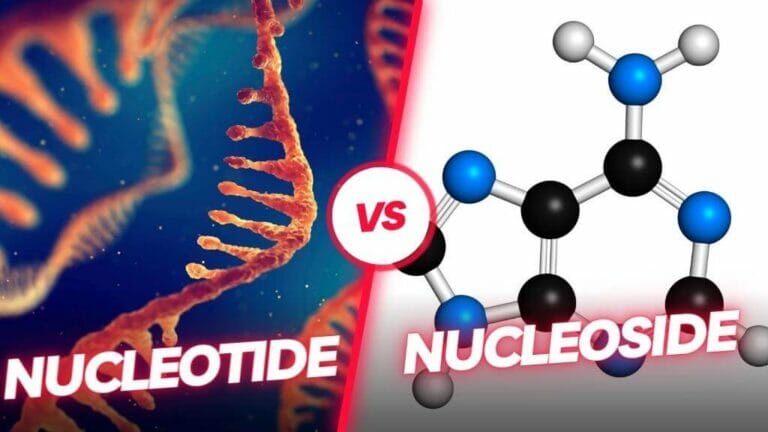The difference between a nucleotide and a nucleoside is that a pentose sugar plus a nitrogenous base make up a nucleoside.
On the other hand, a nucleotide comprises pentose sugar, phosphate groups, and a nitrogenous base.
Both nucleotides and a nucleoside are the main foundation of nucleic acid.
Continue reading this blog to learn about the fundamental differences between a nucleotide and a nucleoside.
Table of Contents
Nucleotide
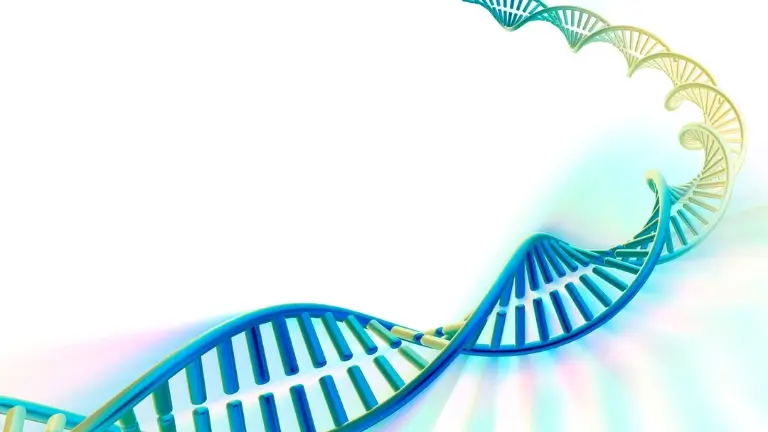
The tiny pieces of DNA called nucleotides are what makeup DNA.
The nucleotide is the building block of DNA and RNA, two essential macromolecules (nucleic acids) in living things.
Biologists prefer to think of them as distinct individuals that can be broken and put back together to form any number of different internal structures.
Numerous distinct nucleotides make up a DNA strand.
There are three parts to each nucleotide. It has a phosphate group, a sugar molecule that is known as deoxyribose in DNA and is the source of the letter D in DNA, and what is known as a nitrogen base.
Carbon, oxygen, hydrogen, and nitrogen make up nucleotides.
Purines are the name given to nucleotides when we divide them into those double rings; hence, nucleotides become purines.
Adenosine, and guanosine, are essential nucleotides.
Characteristics of Nucleotide
- It comprises a sugar, one to three phosphate groups, and a nitrogenous base.
- Its nature is acidic.
- They are elements of coenzymes and energy transporters.
- A nucleoside is a sugar molecule with a nitrogenous base covalently linked, however it lacks phosphate groups.
- It is alkaline in nature.
Uses Of Nucleotide
- It is engaged in the storage of chemical energy.
- It is required for rapidly dividing stages of RNA transcription and DNA replication.
- It supplies cellular energy sources and performs metabolic activities
- It is necessary for chemical interactions in the cells’ reactions to hormones.
Nucleoside
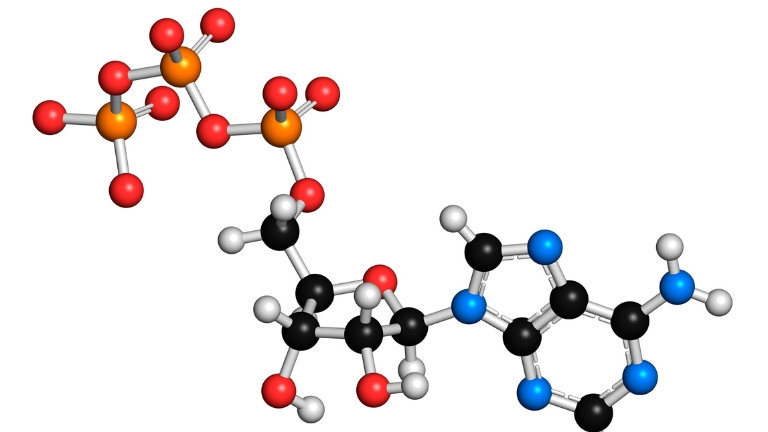
A nucleoside is a molecule that consists of a base attached to a sugar.
The 5-carbon sugar and nitrogenous base are the only components of a nucleoside; phosphate groups are not included.
Nucleoside monophosphate, on the other hand, refers to a nucleoside plus one phosphate.
While nucleoside triphosphate, on the other hand, refers to a nucleoside plus three phosphates.
The phrase is frequently used as part of a chemical name that indicates the number of phosphate groups attached.
Characteristics of Nucleosides
- A nucleoside is made up chemically of a base without the phosphate group and a sugar.
- They are used in medicine as agents that are mainly against cancer-causing and viral agents.
- Adenine becomes adenosine, guanine becomes guanosine, thymine becomes thymidine, cytosine becomes cytidine, and uracil becomes uridine.
- These names are given to the nucleosides based on their nitrogenous bases.
Uses Of Nucleosides
- Nucleic acids use it as their monomeric unit.
- Its high-energy phosphate bonds have a significant amount of chemical energy stored inside them.
- They are used to stop the spread of harmful viruses inside the host cell because they have antiviral characteristics.
- They can also be used as cancer – preventive tools.
Read more: What is the Difference Between Chlorophyll and Chloroplast?
Difference Between a Nucleotide and a Nucleoside
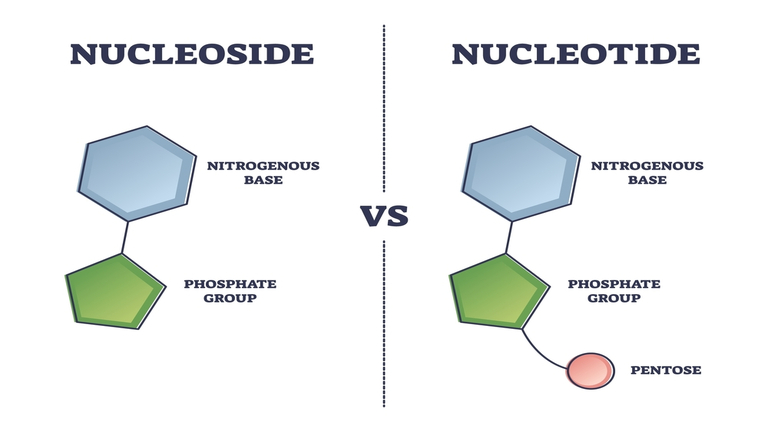
The names nucleoside and nucleotide share some similarities, but they are also distinct in many ways.
The sole difference between a nucleotide and a nucleoside is the presence of phosphate groups in some important examples of nucleosides.
A nucleotide is just a five-carbon sugar plus a nitrogenous base, and phosphate groups, and you can have variable amounts of phosphate groups. Nucleosides can be phosphorylated to generate nucleotides.
A sugar molecule is chemically joined to a phosphate group into the nitrogen base by a nucleotide.
On the other hand, a sugar molecule is chemically linked to the nitrogen base of a nucleoside.
In contrast to nucleosides, which lack the phosphate group, nucleotides have the phosphate group.
Chemically speaking, a nucleotide is acidic, whereas a nucleoside is basic.
The body’s DNA is made up of nucleotides and nucleosides that combine to produce nucleotides.
The enzymes nucleotides and nucleosides are used to hydrolyze the nucleotides and the nucleoside, respectively.
Another difference between nucleotides and nucleosides is that nucleotides can cause cancer development, while nucleosides are used to treat it.
The following are some examples of nucleotides: eurodyne, monophosphate. While Guanosine is one example of nucleoside
Difference Between a Nucleotide and a Nucleoside on the Basis of their Types
Below are the differences between nucleotides and nucleosides.
Types Of Nucleotides
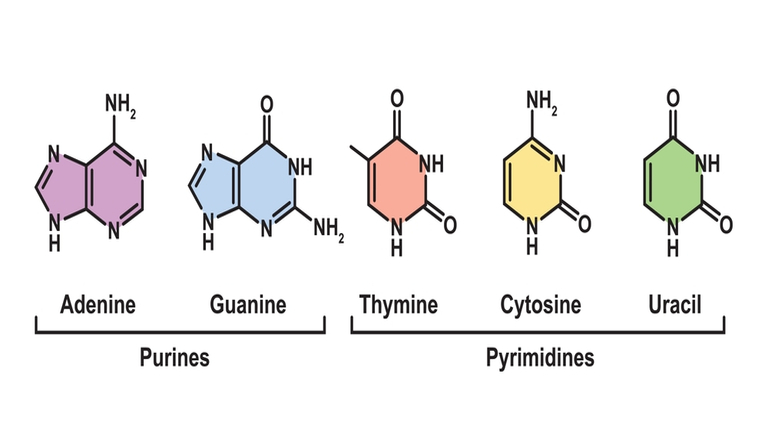
There are five basic types of nucleotides.
1. Adenine
Adenosine triphosphate uses the nucleotide adenine as a base (ATP). Within the purine family is adenine. Strong bonds in ATP can be used to store a lot of energy.
Adenine has the chemical formula C5H5N5.
2. Guanine
One of the four primary bases of nucleic acids is guanine. This identifies it as one of DNA and RNA’s essential building blocks.
Guanine is a purine nucleotide with two rings, similar to adenine. It binds to cytosine both in DNA and RNA. Guanine’s chemical formula is C5H5N5O.
3. Cytosine
A pyrimidine nucleobase, cytosine has the chemical formula C4H5N3O. By having a keto group in position 2, cytosine can be distinguished from the other pyrimidines.
4. Thymine
Thymine is a single-ringed pyrimidine nucleotide, just like cytosine. It joins with adenine to form a link in DNA. Thymine does not exist in RNA.
It only creates two hydrogen bonds with adenine in DNA, it is the weaker of the two. Thymine has the chemical formula C5H6N2O2.
5. Uracil
Uracil has the chemical formula C4H4N2O2. A pyrimidine also exists in uracil. A uracil is a short-lived substance that can degrade into cytosine.
Types of Nucleosides
There are four basic types of nucleosides.
1. Adenosine

In adenosine, an adenine is glycosidically bonded to a ribose sugar, making it a purine nucleoside.
Additionally, adenosine affects bodily processes by generating compounds like cyclic adenosine monophosphate (cAMP).
2. Guanine
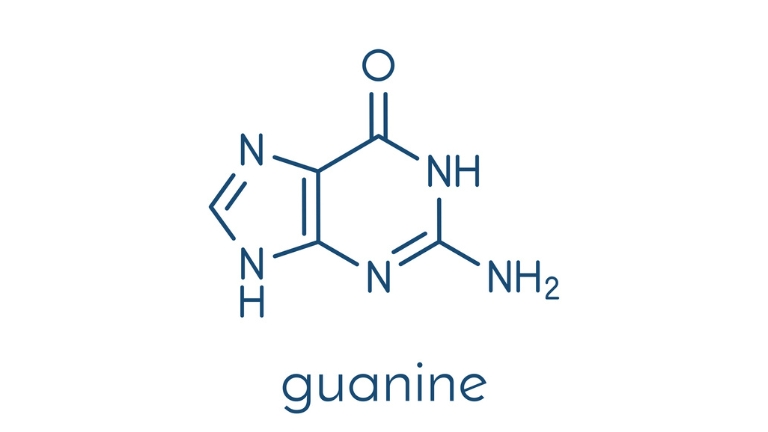
Guanine and ribose sugar combine to form the purine nucleoside known as guanosine.
It has the ability to protect the brain. It lessens oxidative stress and is secreted in the brain.
3. Cytidine
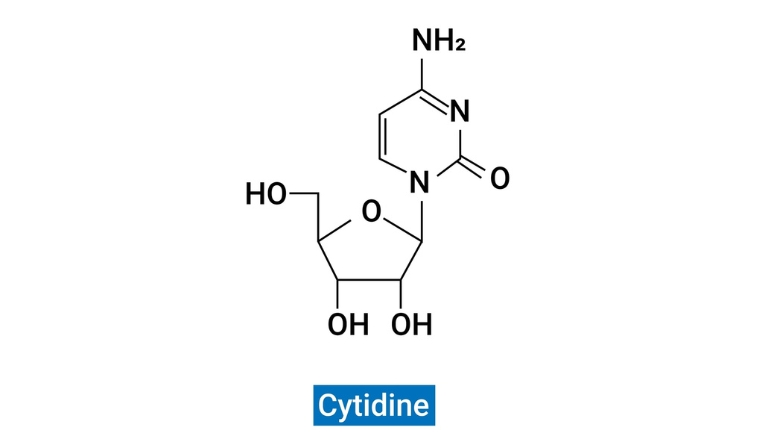
The cytosine sugar ribose is attached to the pyrimidine nucleoside known as cytidine. It might have antidepressant effects.
4. Uracil
A ribose ring, and uracil linked to a ribonucleoside called uridine. It is a tasteless powder that aids in the metabolism of glucose.
What is the Difference Between a Nucleoside and a Nucleotide?
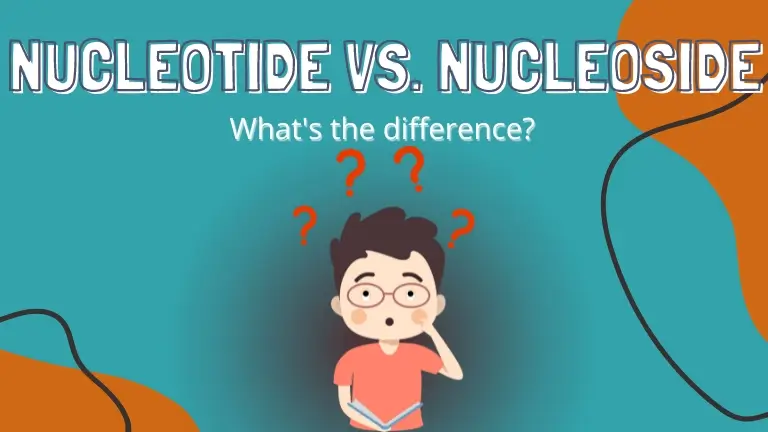
Highlighting the difference between nucleotide and nucleoside in the following table:
| Nucleotide | Nucleoside |
| A phosphate group, a sugar molecule, and a nitrogenous base make up a nucleotide. | Only a sugar molecule and a nitrogen base make up nucleosides. |
| The monomer of the polymeric RNA and DNA is called a nucleotide. | The foundation of nucleotides is the nucleoside. |
| Cancer results from alterations to any N-base in the nucleotide. | Drugs against cancer and viruses are made using nucleosides. |
| Adenine (A), Cytosine (C), Guanine (G), and Thymine (T) are among examples. | Adenosine, cytidine, uridine, and guanosine are a few examples. |
| Nucleotide = Sugar + Nitrogenous base + Phosphate group | Nucleoside = Sugar + Nitrogenous base |
Conclusion
The difference between a nucleotide and a nucleoside is that sugar, a nitrogenous base, and a phosphate group make up a nucleotide’s chemical makeup.
While a nucleoside is only composed of a sugar and nitrogenous base lacking phosphate sugar.
Read more: What is the Difference Between Secretion and Excretion?

